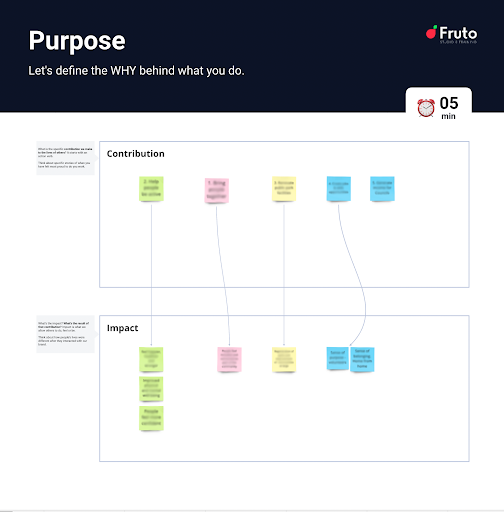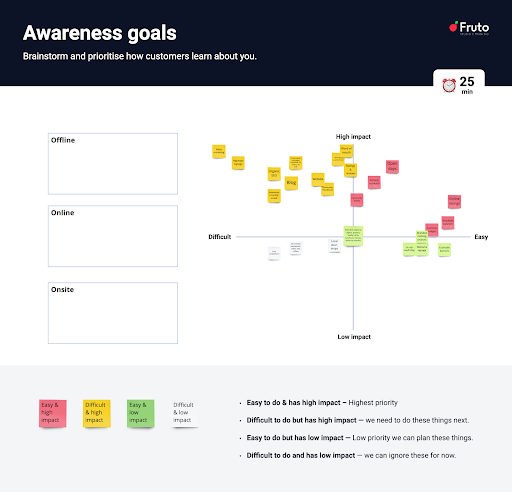What is a brand?
A brand is the perception people have of your business. It's what they think, feel, or say about your business. Even though we might think of ourselves as entirely rational and logical, the truth is that we very much base our decisions on emotion, especially when it comes to purchasing decisions. We might then justify said decisions with logic. Still, at their core, they are driven by a particular emotion and perception of what is valuable to us at a given moment and in a given context.
Brands help people make those decisions when navigating a particular market. Analysing emotional insights to drive your business and serve your audience is critical for the business's long-term success.
How a brand is built: Strategy + Identity
Brand strategy is the foundation upon which your business builds its perception in customer' minds. It’s a plan you create to achieve long-term business goals. A brand makes itself visible to people through elements such as colours, typography, and logo.
1. Brand strategy
What is a brand strategy?
Brand strategy affects a business’ different areas, such as its revenue, growth, company culture, the type of people you employ, the customers you get, and how you communicate with those target customers. A good brand strategy will translate into meeting business goals and competitive advantage in the long term. Running your business without a clear brand strategy can lead to losing control of the brand's perception and direction, ultimately impacting customer retention and the business's overall success. A thought-out brand strategy ultimately helps your business attract new customers (current happy customers will talk about your brand and act as brand ambassadors) and increase brand loyalty with your current customer base.
What areas does your brand strategy cover?
A brand strategy helps your business define the following:
Brand core: Why does your business exist in the first place? What are the principles that guide you in every decision you make? Where is your business headed? These elements help you define the very essence of your brand. Your brand core includes the following:
Purpose
Vision
Values

Brand positioning: How your company is positioned in the market. Who are you targeting? What are your competitors doing? How is your offering unique, and how will people know about it? Your brand positioning includes the following:
Target audience
Market
Awareness tactics

Brand persona: Think of your business as if it were a person. Who would that be? How do they act and communicate with others? Your brand persona includes the following:
Personality
Voice
Brand style attributes
How we approach creating your brand strategy.
A collaborative approach is the best way to create a brand strategy. Involving your team and key stakeholders of your organisation will foster teamwork, align stakeholders, and help your brand go beyond aesthetic appeal, without running the risk of ending up with a strategy that no other in the company believes in.
With this in mind, at Fruto, we run brand strategy workshops that involve all relevant stakeholders and get the team on the same page. We run workshops in-person or remote. When remote, we often use Miro to get the whole team to collaborate in real time.
We split our four-hour brand workshop into three parts (following the three main components of a brand strategy): brand core, brand positioning, and brand persona. The team goes through a few exercises in each part of the workshop.

How we deliver your brand strategy.
Once we have completed the exercises in the workshop, we will analyse the results through thematic analysis and create a custom branding deck that will succinctly summarise the conclusion of each area of your brand strategy.
We recommend you share the branding deck with other stakeholders and make the deck available and easily accessible internally. Ideally, people should be able to access it digitally, and if you have a team office, we encourage you to print key pages in the deck and put them up on the walls! The goal is for the deck to be the one source of truth for your brand's essence and to guide your team's actions.
2. Brand identity
What is a brand identity?
The brand identity makes the intangible tangible. Your brand's identity is made up of things you can see, and it’s an output of your brand strategy. Your brand identity documents your brand’s visual language (logo, colours, images, typography, shapes, layout, etc.) and defines the look and feel of things like your brand’s packaging, website, merchandise, etc. Depending on your business touch-points, you might need more or fewer assets with your brand identity. The brand identity design aims to engage customers in a consistent, easily recognisable way that evokes a specific emotion devised in your strategy.
What areas does your brand identity cover?
When we create a brand identity, we deliver it in a package that includes brand guidelines. The brand guidelines often include:
Logo
Logo variations: The colours (and grayscales) your logo can appear in.
Logo responsiveness: How your logo adapts at different sizes.
Logo minimum sizes: The minimum size at which your brand uses the logo in any given context without losing readability and impact.
Logo clear space: The amount of space the logo must always have around it, no matter where it might be used. Clear space helps your brand be easily recognisable independently of where it might be placed.
Correct usage: How you should use your logo. Against which backgrounds, in which alignments and in what visual contexts.
Incorrect usage: How you mustn’t use your logo. Against which backgrounds, in which alignments and in what visual contexts.
Colour palette: Primary and secondary colours
Typography: Primary and secondary font families. We define the hierarchy, general usage, letter case, line spacing, etc.
Iconography: We might recommend a particular iconography style that works well on brand applications.
Imagery: We might recommend and define guidelines for the imagery your brand might use in different contexts.
How we approach creating your brand identity.
With a clear brand strategy in place, we move on to visualising that strategy in the brand identity phase. Our team will create a logo for your brand or, in some cases, revise your current logo design.
We always step back and consider the brand essence when creating an inspiration board and a series of rough ideas and sketches before refining up to three concepts. We then define the core elements of your visual language, colour and typography, which will help us define additional elements such as imagery, illustration style, etc.
How we deliver your brand identity.
Your brand identity is delivered in a separate section of your branding deck. The sections on your brand strategy might vary depending on your brand identity.
Closing thoughts
Here's a simple rule to remember how a brand's elements fit together:
Brand = The perception in people’s mind
Brand Strategy (intangible) + Brand Identity (tangible) = Branding.
Branding = what you do (tangible and intangible) to build your brand and its offering.
Planning and executing these elements from the beginning will help your business grow and thrive in the long term. Keep an eye out for my next blog on branding, where we look at the impact brand strategy has on your business.
Do you need help with your branding and applying it to your offering experience? Drop us a line.





